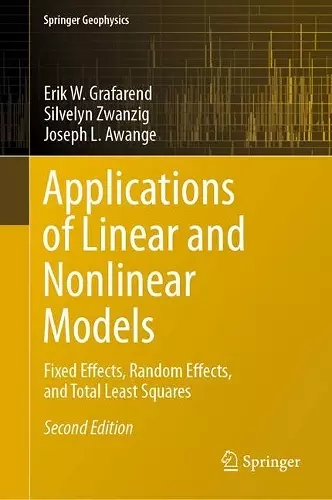Applications of Linear and Nonlinear Models
Fixed Effects, Random Effects, and Total Least Squares
Silvelyn Zwanzig author Joseph L Awange author Erik W Grafarend author
Format:Hardback
Publisher:Springer Nature Switzerland AG
Published:2nd Oct '22
Should be back in stock very soon
This hardback is available in another edition too:
- Paperback£199.99(9783030946005)

This book provides numerous examples of linear and nonlinear model applications. Here, we present a nearly complete treatment of the Grand Universe of linear and weakly nonlinear regression models within the first 8 chapters. Our point of view is both an algebraic view and a stochastic one. For example, there is an equivalent lemma between a best, linear uniformly unbiased estimation (BLUUE) in a Gauss–Markov model and a least squares solution (LESS) in a system of linear equations. While BLUUE is a stochastic regression model, LESS is an algebraic solution. In the first six chapters, we concentrate on underdetermined and overdetermined linear systems as well as systems with a datum defect. We review estimators/algebraic solutions of type MINOLESS, BLIMBE, BLUMBE, BLUUE, BIQUE, BLE, BIQUE, and total least squares. The highlight is the simultaneous determination of the first moment and the second central moment of a probability distribution in an inhomogeneous multilinear estimationby the so-called E-D correspondence as well as its Bayes design. In addition, we discuss continuous networks versus discrete networks, use of Grassmann–Plucker coordinates, criterion matrices of type Taylor–Karman as well as FUZZY sets. Chapter seven is a speciality in the treatment of an overjet. This second edition adds three new chapters:
(1) Chapter on integer least squares that covers (i) model for positioning as a mixed integer linear model which includes integer parameters. (ii) The general integer least squares problem is formulated, and the optimality of the least squares solution is shown. (iii) The relation to the closest vector problem is considered, and the notion of reduced lattice basis is introduced. (iv) The famous LLL algorithm for generating a Lovasz reduced basis is explained.
(2) Bayes methods that covers (i) general principle of Bayesian modeling. Explain the notion of prior distribution and posterior distribution. Choose the pragmatic approach for exploring the advantages of iterative Bayesian calculations and hierarchical modeling. (ii) Present the Bayes methods for linear models with normal distributed errors, including noninformative priors, conjugate priors, normal gamma distributions and (iii) short outview to modern application of Bayesian modeling. Useful in case of nonlinear models or linear models with no normal distribution: Monte Carlo (MC), Markov chain Monte Carlo (MCMC), approximative Bayesian computation (ABC) methods.
(3) Error-in-variables models, which cover: (i) Introduce the error-in-variables (EIV) model,...
ISBN: 9783030945978
Dimensions: unknown
Weight: unknown
1113 pages
Second Edition 2022